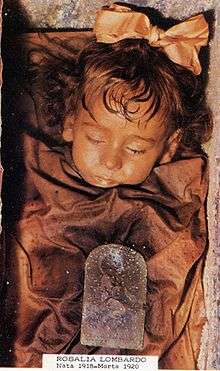Rosalia Lombardo
Rosalia Lombardo (13 December 1918 – 6 December 1920)[1] was an Italian child who died of pneumonia, resulting from the Spanish flu[2] . Rosalia's father, official Mario Lombardo, was sorely grieved upon her death, so he approached Alfredo Salafia, a noted embalmer, to undertake the task of preserving her.[3] Her mummified body, sometimes referred to as "Sleeping Beauty", was one of the last corpses to be admitted to the Capuchin catacombs of Palermo in Sicily.
Rosalia Lombardo | |
|---|---|
 Lombardo's embalmed body in 1982 | |
| Born | 13 December 1918 |
| Died | 6 December 1920 (aged 1) |
| Nationality | Italian |
| Other names | Sleeping Beauty of the Capuchin Catacombs |
| Known for | Being in an especially well-preserved state in her tomb that is located in the Capuchin catacombs of Palermo |
Embalming
Thanks to Salafia's embalming techniques, the body was well-preserved. X-rays of the body show that all the organs are remarkably intact.[4] Rosalia Lombardo's body is kept in a small chapel at the end of the catacomb's tour and is encased in a glass covered coffin, placed on a wooden pedestal. A 2009 National Geographic photograph of Rosalia Lombardo shows the mummy is beginning to show signs of decomposition, most notably discoloration.[5] To address these issues, the mummy was moved to a drier spot in the catacombs, and her original coffin was placed in a hermetically sealed glass enclosure with nitrogen gas to prevent decay.[6] The mummy remains one of the best preserved bodies in the catacombs.
That same year, Capuchin catacombs curator Dario Piombino-Mascali discovered a handwritten manuscript written by Salafia, wherein he lists the ingredients used to mummify Rosalia.[7] The embalming formula is described as "one part glycerin, one part formalin saturated with zinc sulfate and zinc chloride, and one part of an alcohol solution saturated with salicylic acid", and was entered into the body through a single-point injection, most likely into the femoral artery via a gravity injector.[1][8] Rossella Lorenzi of Discovery News reported that the formalin was used to kill bacteria, the glycerin used to prevent desiccation, and the salicylic acid used to eliminate any fungi within the flesh, with the purpose of the zinc salts being petrifaction.[8]
The mummy has achieved further notoriety for a phenomenon in which her eyes appear to open and close several times a day, revealing her intact blue irises.[9] In response to speculation about her moving eyelids, Piombino-Mascali stated that "It's an optical illusion produced by the light that filters through the side windows, which during the day is subject to change ... [her eyes] are not completely closed, and indeed they have never been".[7]
References
- Panzer, Stephanie; Gill-Frerking, Heather; Rosendahl, Wilfried; Zink, Albert R.; Piombino-Mascali, Dario (2013). "Multidetector CT investigation of the mummy of Rosalia Lombardo (1918–1920)". Annals of Anatomy. 195 (5): 401–408. doi:10.1016/j.aanat.2013.03.009.
- https://www.leica-microsystems.com/science-lab/forensics/in-the-catacombs-of-the-capuchin-monastery-in-palermo/
- National Geographic. February 2009. p. 124.
- National Geographic. February 2009. p. 150.
- https://www.nationalgeographic.com/content/dam/magazine/rights-exempt/2009/02/sicily/MM7684_080420_3699.jpg
- "The Girl in the Glass Casket". National Geographic Channel. Archived from the original on 20 October 2012. Retrieved 24 April 2011.
- Rossella Lorenzi (20 June 2014). "Why Does This Mummy Appear To Open And Close Her Eyes?". io9. Discovery News. Retrieved 16 July 2018.
- "Why Does This Child Mummy Appear to Open And Close Her Eyes?". ScienceAlert. 22 September 2014. Retrieved 16 July 2018.
- Reuben Westmaas (16 October 2017). "This Mummified Two-Year-Old Appears to Blink Every Day". Curiosity.com. Retrieved 16 July 2018.
Sources
- Dario Piombino-Mascali, 2009. Il Maestro del Sonno Eterno. Presentazione di Arthur C. Aufderheide. Prefazione di Albert R. Zink. Edizioni La Zisa, Palermo.